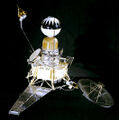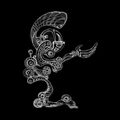Template:Selected anniversaries/January 28: Difference between revisions
No edit summary |
No edit summary |
||
| Line 38: | Line 38: | ||
||1888: Louis Joel Mordell born ... mathematician, known for pioneering research in number theory. Pic. | ||1888: Louis Joel Mordell born ... mathematician, known for pioneering research in number theory. Pic. | ||
||1889: Joseph-Émile Barbier dies ... astronomer and mathematician, known for Barbier's theorem on the perimeter of curves of constant width. Pic search | ||1889: Joseph-Émile Barbier dies ... astronomer and mathematician, known for Barbier's theorem on the perimeter of curves of constant width. Pic search. | ||
||1889: Edwin Crawford Kemble born ... physicist who made contributions to the theory of quantum mechanics and molecular structure and spectroscopy. During World War II, he was a consultant to the Navy on acoustic detection of submarines and to the Army on Operation Alsos. Pic search | ||1889: Edwin Crawford Kemble born ... physicist who made contributions to the theory of quantum mechanics and molecular structure and spectroscopy. During World War II, he was a consultant to the Navy on acoustic detection of submarines and to the Army on Operation Alsos. Pic search. | ||
||1892: Carlo Emilio Bonferroni born ... mathematician who worked on probability theory. Bonferroni is best known for the Bonferroni inequalities (a generalization of the union bound), and for the Bonferroni correction in statistics (which he did not invent but which utilizes his inequalities). Pic. | ||1892: Carlo Emilio Bonferroni born ... mathematician who worked on probability theory. Bonferroni is best known for the Bonferroni inequalities (a generalization of the union bound), and for the Bonferroni correction in statistics (which he did not invent but which utilizes his inequalities). Pic. | ||
| Line 46: | Line 46: | ||
||1903: Dame Kathleen Lonsdale born ... crystallographer who proved, in 1929, that the benzene ring is flat by using X-ray diffraction methods to elucidate the structure of hexamethylbenzene. She was the first to use Fourier spectral methods while solving the structure of hexachlorobenzene in 1931. Pic. | ||1903: Dame Kathleen Lonsdale born ... crystallographer who proved, in 1929, that the benzene ring is flat by using X-ray diffraction methods to elucidate the structure of hexamethylbenzene. She was the first to use Fourier spectral methods while solving the structure of hexachlorobenzene in 1931. Pic. | ||
||1910: Alfredo Capelli dies ... mathematician who discovered Capelli's identity. Pic search | ||1910: Alfredo Capelli dies ... mathematician who discovered Capelli's identity. Pic search. | ||
||1911: Mathematician and academic Robert Schatten born. He made fundamental contributions to functional analysis, where he is the namesake of the Schatten norm and the Schatten class operators. He also studied tensor products of Banach spaces. Pic search | ||1911: Mathematician and academic Robert Schatten born. He made fundamental contributions to functional analysis, where he is the namesake of the Schatten norm and the Schatten class operators. He also studied tensor products of Banach spaces. Pic search. | ||
||1912: Jackson Pollock born ... painter. Pic. | ||1912: Jackson Pollock born ... painter. Pic. | ||
| Line 78: | Line 78: | ||
File:Klaus Fuchs.jpg|link=Emil Julius Klaus Fuchs (nonfiction)|1988: Physicist [[Emil Julius Klaus Fuchs (nonfiction)|Emil Julius Klaus Fuchs]] dies. He was convicted of supplying information from the Manhattan Project to the Soviet Union during and shortly after the Second World War. | File:Klaus Fuchs.jpg|link=Emil Julius Klaus Fuchs (nonfiction)|1988: Physicist [[Emil Julius Klaus Fuchs (nonfiction)|Emil Julius Klaus Fuchs]] dies. He was convicted of supplying information from the Manhattan Project to the Soviet Union during and shortly after the Second World War. | ||
||1993: Helen Sawyer Hogg dies ... astronomer and academic, noted for pioneering research into globular clusters and variable stars. Pic (plaque), pic search | ||1990: F. W. Winterbotham CBE dies ... British Royal Air Force officer (latterly a Group Captain) who during World War II supervised the distribution of Ultra intelligence. His book The Ultra Secret was the first popular account of Ultra to be published in Britain. Pic. | ||
||1993: Helen Sawyer Hogg dies ... astronomer and academic, noted for pioneering research into globular clusters and variable stars. Pic (plaque), pic search. | |||
||1999: Leonard C. Lewin dies ... writer, best known as the author of the bestseller ''The Report from Iron Mountain'' (1967). No pics: https://www.google.com/search?q=Leonard+C.+Lewin | ||1999: Leonard C. Lewin dies ... writer, best known as the author of the bestseller ''The Report from Iron Mountain'' (1967). No pics: https://www.google.com/search?q=Leonard+C.+Lewin | ||
Revision as of 12:10, 22 April 2020
1540: Mathematician and fencer Ludolph van Ceulen born. He will spend a major part of his life calculating the numerical value of the mathematical constant π.
1608: Physiologist, physicist, and mathematician Giovanni Alfonso Borelli born. He will contribute to the modern principle of scientific investigation by continuing Galileo's practice of testing hypotheses against observation.
1855: Geologist Sekiya Seikei born. He will be one of the first seismologists, influential in establishing the study of seismology in Japan and known for his model showing the motion of an earth-particle during an earthquake.
1883: Artist, musician, poet, and alleged time-traveler Edward Lear uses an improvised Runcible to defeat the Forbidden Ratio in single combat.
1884: Physicist and explorer Auguste Piccard born. He will make record-breaking hot air balloon flights, with which he will study Earth's upper atmosphere and cosmic rays, and invent the first bathyscaphe.
1885:Pilot, engineer, and alleged time-traveller Henrietta Bolt predicts that Auguste Piccard will "grow up to reach amazing heights, then go on to reach amazing depths."
1950: Mathematician, theorist, and academic Nikolai Luzin dies. He contributed to descriptive set theory and aspects of mathematical analysis with strong connections to point-set topology.
1961: Brainiac Explains lecture series spends ten weeks on New York Times bestseller list.
1962: Ranger 3 space probe misses the moon by 22,000 miles (35,400 km).
1988: Physicist Emil Julius Klaus Fuchs dies. He was convicted of supplying information from the Manhattan Project to the Soviet Union during and shortly after the Second World War.
2016: Steganographic analysis of Lend a Hand unexpectedly reveals "at least five hundred and twelve kilobytes, maybe two or four times as much" of encrypted Gnomon algorithm functions relating to organic golem technology.










